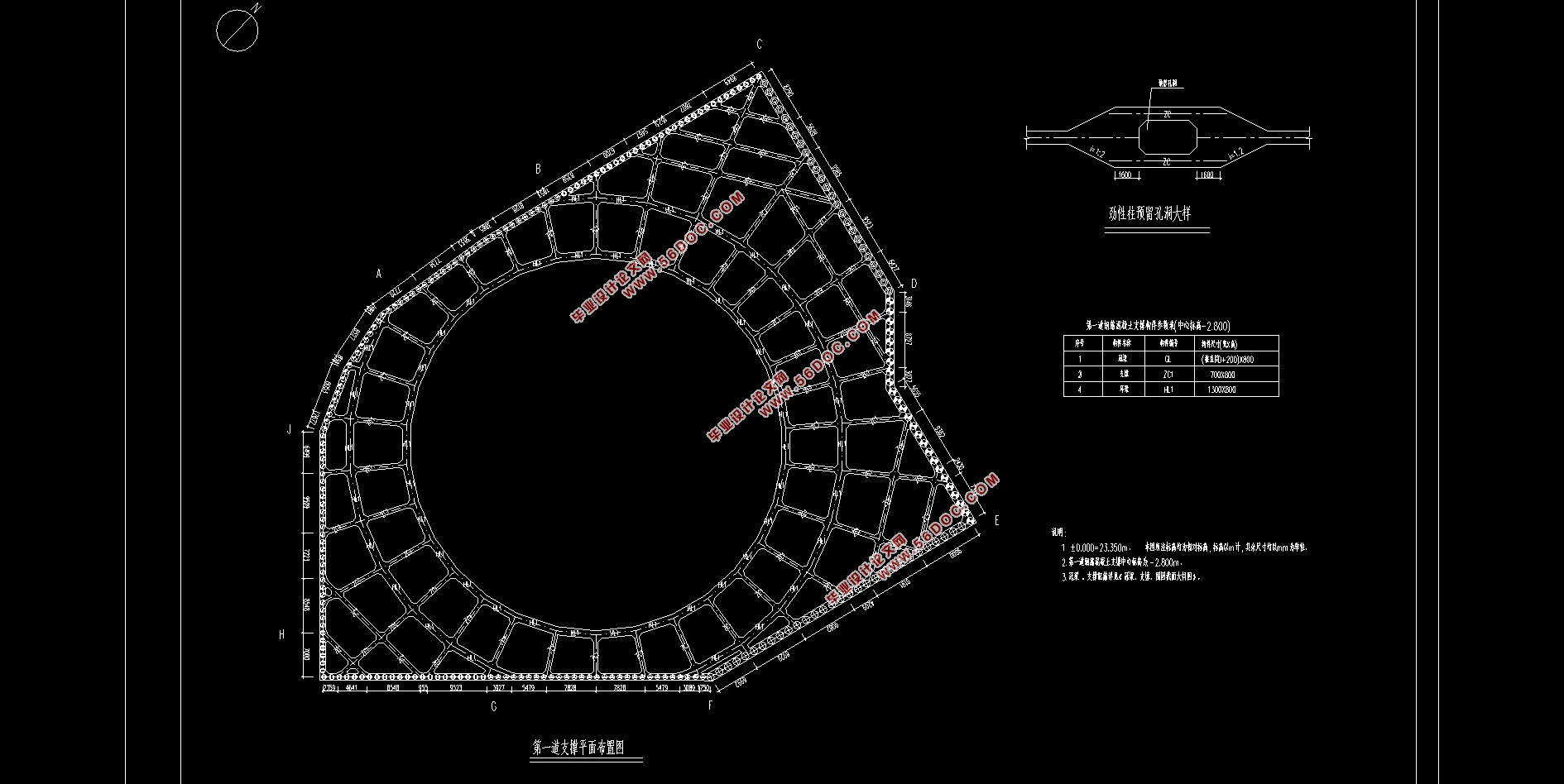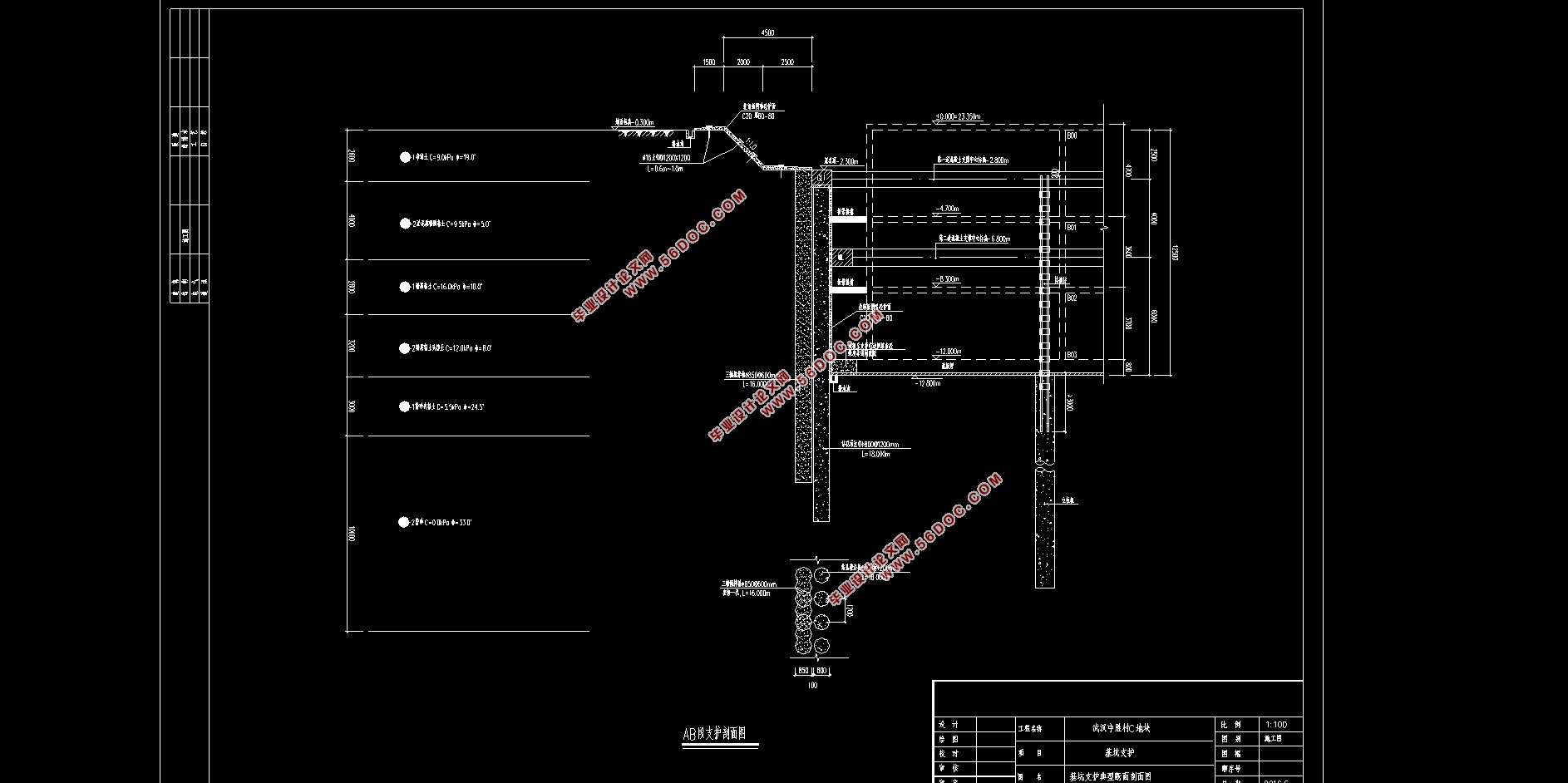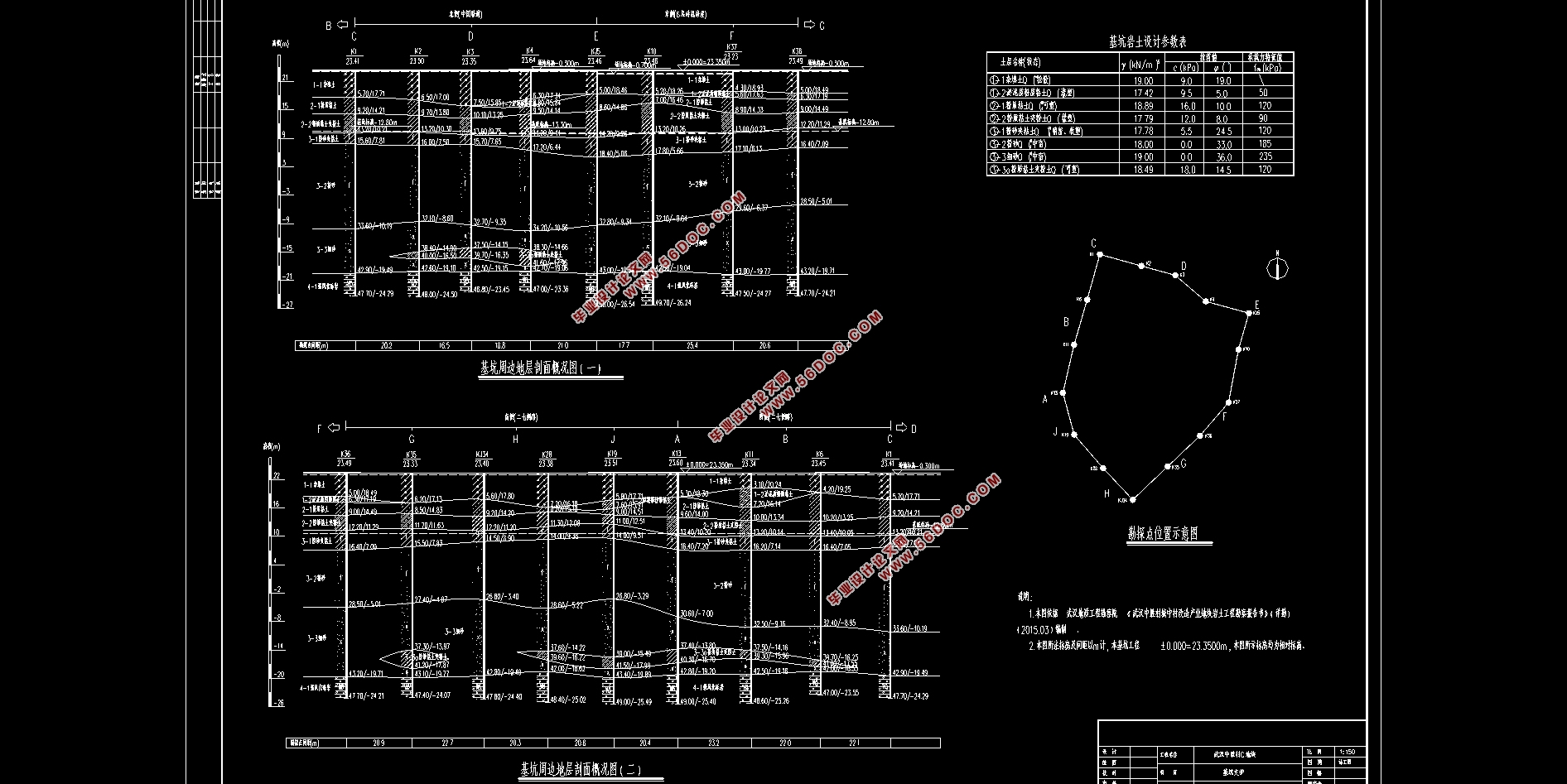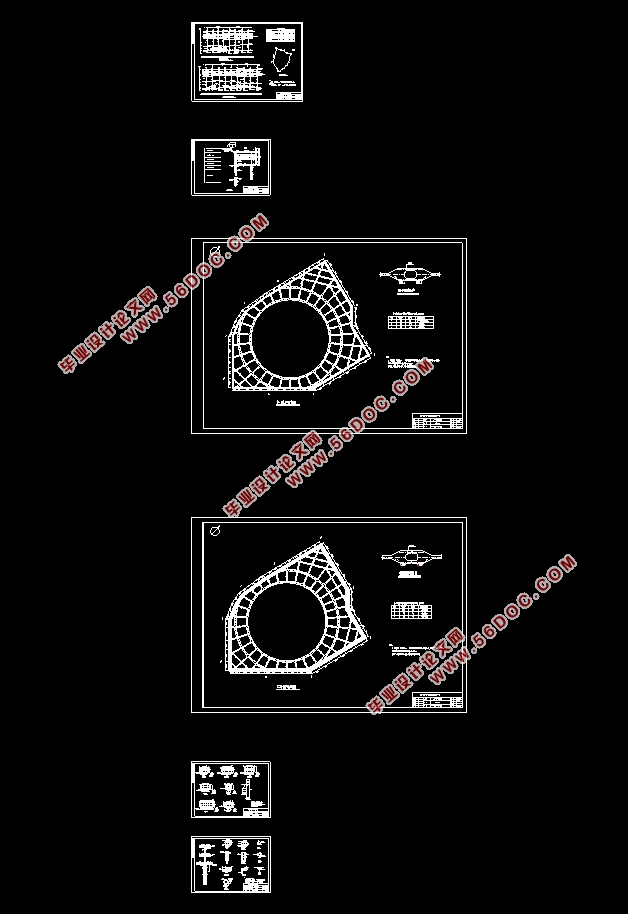深基坑双层环梁内支撑支护结构变形研究(含CAD图)(任务书,开题报告,外文翻译,论文计算书40000字,CAD图6张合一)
摘要
近些年来,随着城市建设的快速发展,我国建筑业发展十分迅速,地下室、地下车库以及地铁车站等地下工程施工也越来越普遍,基坑支护工程已逐渐引起专家学者的关注。环梁式支护结构是近些年来新出现的一种基坑支护结构形式,具有受力性能合理、经济效益好等优点,在基坑支护领域备受青睐,但目前环梁式支护结构的设计计算还存在一些不合理之处,有待解决。
本文阐述了环梁式支护结构的研究现状;分析了环梁支护结构的优越性及存在的问题;对基坑支护设计的基本理论和方法进行总结;以武汉中胜村C地块基坑工程为例,用“天汉”系列基坑工程设计软件,对环梁内支撑系统进行设计计算。探讨了双层环梁内支撑设计计算的几个关键问题,包括水平支撑竖向位置的布置;对三种不同内支撑布置方案的分析;环梁中心点飘移的控制;基坑四周荷载不均衡情况下,内支撑结构边界“约束点”的选择;环梁内支撑水平刚度系数的计算;基坑支护结构分算方法存在的问题及分算方法与整体分析方法的比较等。
本文的创新点在于:①对于双层环梁内支撑,通过控制支撑体系的其他条件不变,只调整第二道支撑竖向位置的方法,对竖向支护桩和水平内支撑的内力、位移进行计算分析,得到第二道支撑竖向位置选择的相关结论;②通过局部加强内支撑结构的刚度,对环梁的受力、变形进行计算分析,得到减小环梁变形、控制环梁中心点飘移的相关结论;③用平面计算软件和三维计算软件分别对同一工程进行设计计算,通过对比分析,总结出基坑支护设计分算方法与整体分析方法各自的适用情况。
通过分析总结,得到以下主要结论及成果:
(1)对于双层环梁式内支撑,适当降低第一道支撑竖向位置和调整两道支撑间距,有利于减小竖向支护桩的桩身最大位移和弯矩,且能够使两道支撑的支撑轴力更加接近,有益于整个支撑体系的稳定,使支撑体系的受力效果更好。
(2)对于四周土压力荷载分布不均的基坑,局部加强水平内支撑的刚度较弱处、传力路径单一处、受外荷载较大处的刚度,有利于减小环梁变形和对环梁中心点飘移的控制,其中局部加强内支撑受外荷载较大处刚度的效果最明显。
(3)内支撑结构边界“约束点”的选择,应使引入约束支座后的内支撑结构的位移状态与实际相符,约束支座应设置在位移为0的位置与方向上,其支座反力理论上应为0。用“天汉”软件对四周土压力荷载分布明显不均的基坑进行计算时,若支撑位移图变形过大,需对其进行整体平衡判断,并反复调整土压力荷载值和设置不同的边界约束,直至位移支撑图为实际中可能的变形为止,否则计算出的内支撑位移和内力值不够准确。
(4)基坑支护结构分算方法虽然存在一些不合理之处,但在基坑周围土压力荷载均衡的条件下,采用分算方法和整体分析方法对支护结构进行设计计算的结果较接近,且分算方法计算经验丰富,其计算结果的准确性更有保证,应优先选用分算方法;当基坑周围土压力荷载不均衡时,采用分算方法易出现环梁中心点飘移问题,且内支撑边界约束支座难以确定,其计算结果误差较大,而整体分析方法不存在这些问题,应优先选用整体分析方法进行设计计算。
关键词:基坑支护;环梁内支撑;边界约束;中心点飘移
Abstract
In recent years, with the rapid development of urban construction. China's construction industry developed rapidly. Basement, underground garages and subway stations, as well as underground construction is becoming more and more common. Foundation pit support engineering gradually caught the attention of experts and scholars. Ring beam supporting structure is emerging in recent years, a form of foundation pit support structure. It has the advantages of mechanical properties and good economic returns, it is popular in the field of foundation pit support. But there are some unreasonable of the design of ring beam supporting structure, to be resolved.
The status quo and problems of a pit ring beam to support retaining structure is described, and the superiority of the ring beam retaining structure is analysed in this article. The basic theory and method for design of foundation pit supporting is summarized; Combination the C block of Wuhan zhongsheng village foundation pit, the ring beam bracing system is designed and calculated by “TianHan” series of excavation engineering design software. The designation and calculation for double ring beam support are discussed in several key problems, including the vertical location arrangements of horizontal support; Analysis of three different layout of internal bracing structure; The control of ring beam focal point drift; The choice of internal bracing's constraint points in foundation pit surrounded by uneven load; The calculation of horizontal stiffness coefficient of ring beam supporting; The problems of split method to foundation pit support structure and the comparison of split method and integral analysis method etc.
Innovation of this paper : ① For two-tier ring beam supported by control support system of other conditions do not change, only adjust the vertical positions of the second beam supported. On vertical piles and lateral bracing analysis of internal forces and displacements are calculated, and the relevant conclusions of the vertical positions of second choice is drew. ② Through the local reinforcement of rigidity of bracing structure, the force and deformation of ring beam are calculated and analysed, and come to the conclusion which is relevant to the reducing deformationof ring beam and the controlling focal point drift of ring beam. ③ Calculation software for two dimensional and three dimensional are used for the same project to design. Through comparison and analysis, summarizes the applicable to split method and integral analysis method.
Through analysis and summary the following key conclusions and results are reached:
(1) For two-tierring beam bracing, reducing the vertical positions of first beam bracing appropriately and adjusting the spacing between two internal bracing is good to decrease the maximum value of vertical pile displacement and bending moment, and it also can make closer to supporting axial force of the two beam bracing, it’s benefit to the stability of the whole support system and make the supporting system load better.
(2) To uneven distribution of earth pressure loads for a excavation, local strengthening the stiffness where the horizontal supporting stiffness is weak, load paths is only one and the under external loads is bigger. it's good to reduce the deformation of ring beam and the control of ring beam focal point drift. Where the effect of local strengthening of stiffness of under external loads larger is most pronounced.
(3) The choice for the boundary constraint points of support structure should make the displacement of supporting structure in line with the actual, and the constraints support should be set on the position and direction of the displacement is 0, The reaction force of the constraints support should be 0 in theory. The foundation pit arounded uneven load by “TianHan” series of excavation engineering design software is calculated, if the distortion of displacement diagram is too large, the total balance needs to determine, and repeatedly adjusted the earth pressure load and calculation until the displacement diagram of internal bracing is consistent with the actual, otherwise the calculated internal displacements and internal forces is inaccurate.
(4) Although there are some unreasonable in split method, but when the soil pressure around the excavation is balanced, the results of support structure design and calculation by split method and integral analysis method is near, and the split method is experienced, it should be preferred. When the soil pressure around the excavation is unbalanced, split method maybe have the problem of circular beam focal point drift, and the boundary constraint points of support structure is difficult to determine, and it’s results not accurate enough, but integral analysis method does not have these problems, so the integral analysis method should be used firstly.
Key words: retaining and protecting for foundation pit; ring beam bracing; boundary constraint; focal point drift
本文主要工作内容:
(1)阐述环梁式内支撑的研究现状及基本概念。
(2)简述基坑支护设计计算的基本理论与方法。以武汉中胜村C地块基坑工程为例,利用“天汉”系列基坑工程设计软件进行设计计算,包括对上部放坡的稳定性验算、钻孔灌注桩排桩的设计计算、内支撑结构体系(冠梁、围囹、环梁、辐射撑、角撑、立柱等)的设计计算,并分析了该工程内支撑的施工工况、换撑设计和地下水处理设计等。
(3)结合武汉中胜村C地块基坑工程实例,探讨了双层环梁内支撑设计计算的几个关键问题,包括水平支撑竖向位置的布置;对三种不同的内支撑布置方案的分析;环梁中心点飘移的控制;基坑四周荷载不均衡情况下内支撑结构边界“约束点”的选择;环梁内支撑水平刚度系数的计算;环梁支护结构受到偏心压力荷载的作用;基坑支护结构分算方法存在的问题及分算方法与整体分析方法的比较等。
工程概况
武汉中胜村C地块位于武汉市江岸区建设大道以西,空军雷达学院体育馆以东,包括1栋高层办公楼(39层)、1栋3层商业楼及整体地下车库(负3层),规划总用地面积10230m2,总建筑面积约80387.95m2。结构类型:39层塔楼为核心筒结构,商业裙楼和地下室为框架结构,其中塔楼高度为147.65m,3层商业裙楼高度约14.45m,地下车库建筑面积约18189.85m2,三层地下车库高度约为10.8m。
工程设计±0.00=23.35m(以下标高如不说明,均为相对±0.00的标高)。基坑形状近似扇形,如图4.1,场地绝对标高平均约为23.05和22.65m(相对标高-0.30m/-0.70m)。基坑以地下室外墙线外扩1.50m为基坑底边线,地下室基坑底边线支护面积约为6604.5m2左右,支护周长约为319.2m左右。





目录
摘要 I
Abstract III
第1章 绪论 1
1.1概述 1
1.2基坑工程支护的主要类型 1
1.3深基坑环梁支护结构的研究现状 2
1.4本文工作内容 3
第2章 环梁内支撑结构的基本概念 4
2.1环梁内支撑结构的发展 4
2.2环梁内支撑结构的特点 4
2.3环梁内支撑结构的构造 5
2.4环梁内支撑结构的平面布置 6
第3章 基坑支护设计的基本理论与方法 7
3.1作用于支护结构上的荷载 7
3.1.1土压力理论 7
3.1.2水平荷载计算 9
3.1.3水平抗力计算 10
3.2支护结构设计计算理论 10
3.2.1静力平衡法 10
3.2.3等值梁法 11
3.2.3弹性抗力法 12
3.3支撑、锚杆水平刚度系数的确定 13
3.4多层支撑支护结构等值梁法的计算 14
第4章 武汉中胜村C地块基坑工程实例 17
4.1工程概况 17
4.1.1周边环境概况 18
4.1.2工程地质条件 18
4.1.3水文地质条件 21
4.2基坑支护方案的选择 22
4.2.1基坑特点分析 22
4.2.2支护方案比选 22
4.3基坑支护设计 23
4.3.1基坑设计依据 23
4.3.2基坑设计原则 24
4.3.3基坑支护设计参数确定 24
4.3.4设计计算模型 24
4.3.5总体支护方案布置 25
4.3.6上部支护设计 25
4.3.7钻孔灌注桩排桩设计 28
4.3.8内支撑结构设计 36
4.3.9内支撑施工工况 76
4.3.10换撑设计 77
4.3.11隔水(渗)帷幕设计 77
4.3.12桩间高压旋喷桩加固设计 77
4.4地下水处理设计 78
4.4.1地下水控制设计原则 78
4.4.2设计思路 78
4.4.3基坑排水设计 78
4.5小结 81
第5章 双层环梁内支撑设计计算的几点探讨 82
5.1水平支撑竖向位置的讨论 82
5.1.1四种桩-撑支护方案参数信息 82
5.1.2计算结果比较分析 82
5.2环梁中心点飘移的控制 86
5.2.1三种内支撑结构方案参数信息 86
5.2.2计算结构比较分析 87
5.3内支撑结构边界“约束点”的选择 91
5.4环梁支护结构的水平刚度系数 93
5.5基坑支护结构分算方法存在的几个问题 94
5.6基坑支护分算方法与整体分析方法的比较 94
5.6.1空间有限元数值模拟计算 95
5.6.2分算方法与整体空间分析方法的比较 99
5.7小结 100
第6章 结论和展望 102
6.1结论 102
6.2展望 103
参考文献 105
附录A 107
|











